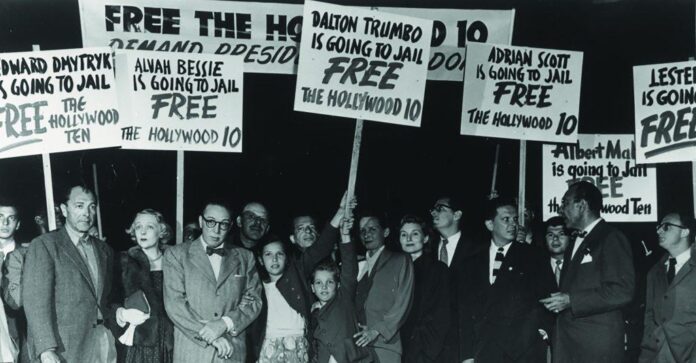In an era when one faction of America’s political establishment claims socialists control the entertainment and media industries, it’s worth noting the plain obvious: America has been here before.
As Cold War battle lines hardened and America flexed its might across the globe in the 1940s, inwardly it began scouring industries for communist infiltrators. The House on Un-American Activities Committee led the charge and in 1947 put Hollywood on trial before Congress. One outcome was the jailing of recalcitrant industry figures, the infamous Hollywood Ten; another was a secret meeting at New York’s Waldorf Astoria Hotel at which politicians forced studio heads to persecute those with Communist Party ties.
A telegram invitation to this Waldorf Conference is among the more than 100 objects presented at Los Angeles’s Skirball Cultural Center in an exhibition that tells the story of how America’s film industry abandoned civil liberties under corporate and political pressure. On show through September 3, “Blacklist: The Hollywood Red Scare” is a collision of film and civic history that leads visitors to contemplate the lives ruined, the movies never made, and the ominous echoes in today’s polarized world.
“‘Blacklist’ highlights issues of persecution, loss of civil liberties, as well as the dangers of propaganda,” Cate Thurston, the exhibition’s curator told Artnet News, noting the show has particular resonance in the context of the writer’s strike. “Dynamic history exhibitions like ‘Blacklist’ are built to facilitate critical thinking about contemporary issues through nuanced explorations of the past.”
First produced by the Jewish Museum Milwaukee, the Los Angeles exhibition is twice the size of the original and fittingly teems with Hollywood artifacts sourced from the Writers Guild of America West archives and the Margaret Herrick Library.
Dalton Trumbo features prominently. Trumbo was one of the best-paid screenwriters in the 1940s before being blacklisted for Communist Party affiliations and forced to write under pseudonyms. He did so with remarkable prolificacy. “Blacklist” displays his screenplay for as well as the Oscar statuettes he received for (1953) and (1956), neither of which he was able to collect without compromising his identity.

Screenwriter Dalton Trumbo served 11 months in the federal penitentiary in Ashland, Kentucky, in 1950. While incarcerated, Trumbo stored some of his personal belongings in typewriter ribbon tins. The items he kept included a calendar and notes from his children. Photo courtesy of Mitzi Trumbo.
Given the prominent position Jewish people occupied in Hollywood, many of the exhibits speak to the conflicting way Jews both patrolled and disproportionally suffered in the climate of red panic. The aforementioned telegram was addressed to Louis B. Mayer, co-founder of Metro-Goldwyn-Mayer studios, the so-called King of Hollywood, whose studio would go on to rigorously enforce the government line. On the opposing side were First Amendment advocates, many of whom focused on the civil injustices dealt to Hollywood Ten—one lobbyist was Lauren Bacall (neé Betty Joan Perske) whose costume for (1953) is on show.
“Many of the creatives and executives affected by the blacklist were Jewish,” Thurston said, “Antisemitism is an explicit theme throughout the exhibition and many of the artifacts the Skirball added demonstrate how antisemitism shaped the Hollywood Blacklist.” For Thurston, curating the show had a personal resonance given Red Scare politics impacted several members of her family: some fled to Europe, others scraped by writing magazine articles under invented names.

Lauren Bacall’s costume for her role as Schatze Page in (1953), designed by William Travilla. Courtesy of Larry McQueen Film Costume Collection.
As with previous Skirball exhibitions, such as a look at ’s impact on visual culture and the legacy of master puppeteer Jim Henson, “Blacklist” is shadowed by a summer-long film program. The season begins with the 2007 documentary in which the writer tells his own story, and goes on to screen classics penned by blacklisted writers including (1952) and (1950), as well as (1973) that is based off Arthur Laurents’s experiences with the House Un-American Activities Committee.
“Skirball welcomes opportunities to honor memory and facilitate dialogue about how collective historic memories influence contemporary American attitudes,” Thurston said. “My hope is that visitors come to the exhibition and make connections for themselves.”
See more images from the exhibition below.

Installation view of “Blacklist” at the Skirball Cultural Center. Photo courtesy Skirball Cultural Center.

Dalton Trumbo’s Academy Award for Best Original Story for , awarded to the fictious Robert Rich (1956), Courtesy of Molly Trumbo Gringas.

Booklet, Committee on Un-American Activities, U.S. House of Representatives, Washington, D.C. (revised 12/1/1950). Courtesy of the Jewish Museum Milwaukee collections.

Installation view of “Blacklist” at the Skirball Cultural Center. Photo courtesy Skirball Cultural Center.

Union flyer promoting the opening of (1954). Courtesy of the Herbert Biberman and Gale Sondergaard Papers, Wisconsin Center for Film and Theater Research.

Installation view of “Blacklist” at the Skirball Cultural Center. Photo courtesy Skirball Cultural Center.

Alfred L. Levitt’s Writers Guild of America membership cards from 1965 to 1982 list both his real name and his front, Tom August. On loan from the Screen Writers Guild Records, Writers Guild Foundation Library and Archive

























